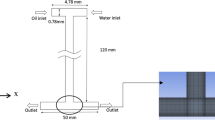Abstract
This paper reports the findings of a numerical investigation on the droplet break-up in a microfluidic T-junction. The numerical flow visualization of the droplet formation process is validated with the experimental flow visualization. From the computational results, we show that the pressure profile of the dispersed phase and the continuous phase in the squeezing regime changes as the droplet break-up process proceeds. The assumption taken by other researchers that the dispersed phase pressure profile, during the droplet formation process at a T-junction, remains constant and only the continuous phase pressure changes according to the blockage of the channel is proved to be invalid. We provide new insights on the pressure difference between the dispersed phase and the continuous phase during the droplet break-up process and show that the minimum pressure difference happens at the last moment of the droplet break-up and not during the second and third stage of the droplet formation mechanism in the squeezing regime as suggested by other researchers.











Similar content being viewed by others
References
Bringer MR, Gerdts CJ, Song H, Tice JD, Ismagilov RF (2004) Microfluidic systems for chemical kinetics that rely on chaotic mixing in droplets. Philos Trans Math Phys Eng Sci A 362(1818):1087–1104
DeMenech FJM, Garstecki P, Stone H (2008) Transition from squeezing to dripping in a microfluidic T-shaped junction. J Fluid Mech 595:141–161
Fuerstman MJ, Lai A, Thurlow ME, Sergey HAS, Shevkoplyas S, Whitesides GM (2007) The pressure drop along rectangular microchannels containing bubbles. Lab Chip 7:1479–1489
Garstecki P, Fuerstman MJ, Stone HA, Whitesides GM (2006) Formation of droplets and bubbles in a microfluidic T-junction—scaling and mechanism of break-up. Lab Chip 6(3):437–446
George EO, Whitesides M, Takayama S, Jiang X, Ingber DE (2001) Soft lithography in biology and biochemistry. Ann Rev Biomed Eng 3:335–373
Gordon JAT, Christopher F, Noharuddin NN, Anna SL (2008) Experimental observations of the squeezing-to-dripping transition in T-shaped microfluidic junctions. Phys Rev 78:036317
Guillot P, Colin A (2005) Stability of parallel flows in a microchannel after at junction. Phys Rev E 72:066301
Gunther A, Khan SA, Thalmann M, Traschel F, Jensen K (2004) Transport and reaction in microscale segmented gas–liquid flow. Lab Chip 4:278–286
Gunther A, Khan SA, Thalmann M, Trachsel F, Jensen KF (2004) Transport and reaction in microscale segmented gas-liquid flow. Lab Chip 4(4):278–286
Gunther A, Jhunjhunwala M, Thalmann M, Schmidt MA, Jensen KF (2005) Micromixing of miscible liquids in segmented gas–liquid flow. Langmuir 21(4):1547–1555
Liu H, Zhang Y (2009) Droplet formation in a T-shaped microfluidic junction. J Appl Phys 106:034906
Long Sang YH, Wang F (2009) Investigation of viscosity effect on droplet formation in T-shaped microchannels by numerical and analytical methods. Microfluid Nanofluid 6:621–635
Muradoglu M, Stone HA (2005) Mixing in a drop moving through a serpentine channel: a computational study. Phys Fluids 17(7):1–9
Nisisako T, Okushima S, Torii T (2005) Controlled formulation of monodisperse double emulsions in a multiple-phase microfluidic system. Soft Matter 1(1):23–27
Sivasamy J, Chim YC, Wong T-N, Nguyen N-T, Yobas L (2010) Reliable addition of reagents into microfluidic droplets. Microfluid Nanofluid 8:409–416
Song H, Bringer MR, Tice JD, Gerdts CJ, Ismagilov RF (2003) Experimental test of scaling of mixing by chaotic advection in droplets moving through microfluidic channels. Appl Phys Lett 83(22):4664–4666
Song H, Chen DL, Ismagilov RF (2006) Reactions in droplets in microfluidic channels. Angew Chem Int Ed 45(44):7336–7356
Squires TM, Quake SR (2005) Microfluidics: Fluid physics at the nanoliter scale. Rev Mod Phys 77(3):977–1026
Stone HA, Stroock AD, Ajdari A (2004) Engineering flows in small devices: microfluidics toward a lab-on-a-chip. Annu Rev Fluid Mech 36:381–411
Teh S, Lin R, Hung L, Lee AP (2008) Droplet microfluidics. Lab Chip 8(2):198–220
Thorsen T, Roberts RW, Arnold FH, Quake SR (2001) Dynamic pattern formation in a vesicle-generating microfluidic device. Phys Rev Lett 86(18):4163–4166
Tice JD, Lyon AD, Ismagilov RF (2004) Effects of viscosity on droplet formation and mixing in microfluidic channels. Anal Chim Acta 507(1):73–77
Utada AS, Lorenceau E, Link DR, Kaplan PD, Stone HA, Weitz DA (2005) Monodisperse double emulsions generated from a microcapillary device. Science 308(5721):537–541
Xu JTJH, Li SW, Luo G (2008) Correlations of droplet formation in T-junction microfluidic devices: from squeezing to dripping. Microfluid Nanofluid 5:711–717
Zheng B, Ismagilov RF (2005) A microfluidic approach for screening submicroliter volumes against multiple reagents by using preformed arrays of nanoliter plugs in a three-phase liquid/liquid/gas flow. Angew Chem Int Ed 44(17):2520–2523
Author information
Authors and Affiliations
Corresponding author
Rights and permissions
About this article
Cite this article
Sivasamy, J., Wong, TN., Nguyen, NT. et al. An investigation on the mechanism of droplet formation in a microfluidic T-junction. Microfluid Nanofluid 11, 1–10 (2011). https://doi.org/10.1007/s10404-011-0767-8
Received:
Accepted:
Published:
Issue Date:
DOI: https://doi.org/10.1007/s10404-011-0767-8




